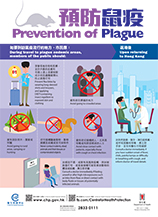Plague
2024-03-15
Plague is a communicable disease that affects rodents, some animals and humans. It is caused by the bacteria Yersinia pestis. There are three main forms of plague infection: bubonic, pneumonic and septicaemic. Plague in human is a serious disease with a case-fatality ratio of 30% – 60% for the bubonic type, and is always fatal for the pneumonic type when left untreated.
For details, please refer to the factsheet of plague.
|
||||||||
